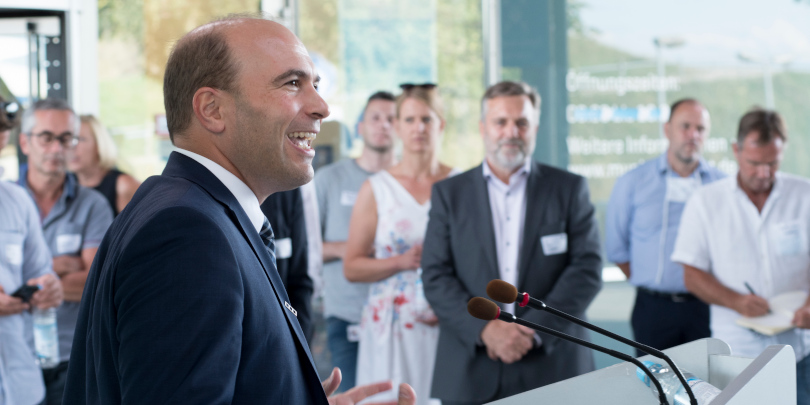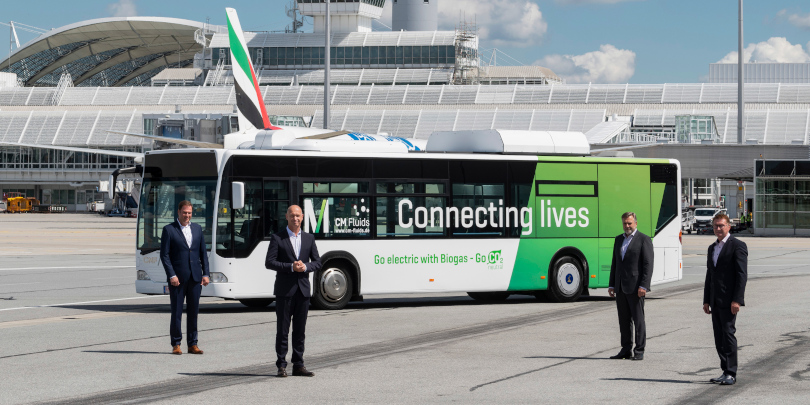Converting City Buses Into Carbon-Neutral Hybrid Vehicles

Pilot Project on the Airport in Munich
We are one of the world's 100 largest suppliers to the automotive industry, and CM Fluids, a start-up from the biogas industry, have successfully converted a diesel-powered bus into an innovative carbon-neutral hybrid vehicle with a gas-powered engine and backup battery.
The pilot project involves a passenger bus at Munich Airport, but the new drive concept was designed for city buses. A pilot project generally takes quite a long time to complete – the optimum solution process is too unclear, the time frame too vague. But it can also be fast and efficient, as proven by the joint project by Webasto, CM Fluids and Flughafen München GmbH, in which the partners took just eleven months to modify a Munich Airport passenger bus by equipping it with a carbon-neutral generator-electric hybrid drive. The team, which includes employees from all three project partners, succeeded in developing a tailored solution for passenger buses on the airport apron. The airport has an ambitious goal: The entire airport’s operations should be carbon neutral by 2030 at the latest. - Modifying the fleet of crew and airport passenger buses is one of the many measures en route to carbon neutrality.

A Pure Battery-Powered Electric Drive Is Not an Option - A Hybrid Alternative Is the Solution
The idea of modifying buses by equipping them with a pure battery-powered electric drive is an obvious choice. However, the requirements at the airport did not fit the bill. On average, the airport passenger buses on the grounds of Munich Airport travel around 14 kilometres (9 miles) every hour, which is pretty low mileage, and delayed take-offs and landings make their routes difficult to plan. So this takes the option of using opportunity charging – regularly charging the buses at specific points when not in use – off the table, especially as the charging infrastructure would need to be created for and the required energy supply adapted to all-electric operation.
CM Fluids is supplying an appropriate alternative with CMF drive, its patented drive concept that combines the high range of a combustion engine with the benefits of an electric drive with an on-board gas-powered charging station. In this pilot project, the normal drive axle in a Mercedes Citaro has been replaced with an electric axle, which is powered by two Webasto batteries connected in series. They, in turn, draw their energy from a small gas engine generator unit powered by liquid biomethane. This approach takes the buses’ long operating times and frequent stopping and starting into account: The vehicle can be refilled with 500 litres of fuel in just five minutes, which lasts for around 800 kilometres (500 miles).

Hybrid Concepts for City Buses Make Sense
CMF drive is perfect for urban public transport, as the backup battery stores the braking energy generated while driving so that the bus can reuse it – perfect for city buses that stop and start frequently. The concept has also been formulated with other challenging set-ups in mind, such as public transport in mountainous regions or long, regional routes. Heavy-duty communal vehicles, such as refuse collection vehicles, can also be converted to this method for economical and ecological purposes.
Webasto was soon confirmed as the company supplying the batteries for this concept, as the modular systems made by the Bavarian automotive industry supplier combine the great price of a scalable plug-and-play product with the accuracy and adaptability required for custom solutions. “This is often an unbeatable selling point for our customers: They get a custom solution based on our standard batteries without having to accept high development costs, yet with the tried-and-tested Webasto quality every time,” said Manuel Kagelmann, Webasto’s Head of Product Portfolio Domain Batteries in the aftermarket segment. Thanks to its low average speed and the gas engine, the modified Mercedes Citaro needs a battery capacity of just 70 kilowatt hours, which is guaranteed through the two 400 V batteries generating a drive voltage of 800 volts.
Another selling point: Webasto controls the batteries using a vehicle interface box (VIB), which also enables the energy recovered from the braking system to be quickly sent to the backup storage in the two batteries. This also makes it easier to connect the individual elements of the drive concept. “Getting the hybrid drive’s components to successfully communicate with each other was the biggest challenge in the project,” said Dr Markus Ostermeier, Head of CMFdrive at CM Fluids.

An Award-Winning, Low-Cost Solution
The concept, which recently received the German Gas Industry Innovation Award, is a major win for Munich Airport: “We received a perfect, low-cost solution for use at the airport, as we were able to successfully modify a vehicle from our fleet,” said Tobias Prechtl from the Technical Service division of Flughafen München GmbH. “The modification only costs around half what it would to convert to an all-electric vehicle. Purchasing a brand new bus would be much more expensive than this.”
This modification has also helped to achieve the airport’s primary goal of reducing the bus fleet’s emissions, as using liquid biomethane as a fuel guarantees carbon neutrality. Compared to a Euro 6 diesel engine, it produces up to 90% fewer fine particles and more than 60% less nitric oxide. There may also be the option to create a closed circuit at Munich Airport, so that it can generate its own fuel using the green waste from the airport’s grassed areas.
This conversion is Webasto’s first hybrid project. “Many Webasto battery systems can already be found in a wide range of vehicles. The project with CM Fluids is a successful example of how modifying vehicles with battery systems can combine the benefits of a combustion engine with the advantages of an electric drive,” said Kagelmann.
The Munich Airport bus is currently in the pilot phase. If this phase is a success, there are plans for further crew and airport passenger vehicles to be modified.
